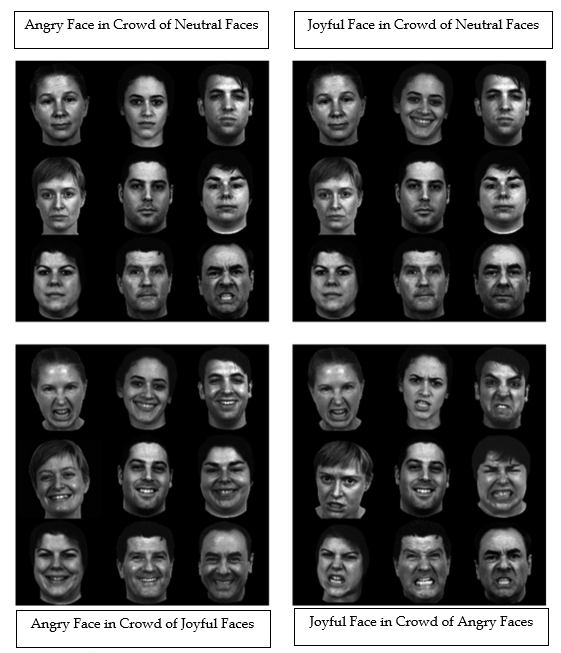Chapter 8: Fear, Anxiety, and Stress
Evolutionary Evidence – Visual Search Paradigm
Figure 6
Visual Search Paradigm from Pinkham et al. (2010)

Adapted from “The face in the crowd effect: Anger superiority when using real faces and multiple identities. ,” by A.E. Pinkham, M. Griffin, R. Baron, N.J. Sasson, and R.C. Gur, 2010, Emotion, 10(1), p. 143. (The face in the crowd effect: Anger superiority when using real faces and multiple identities.). Copyright 2010 by American Psychological Association.
Long Description
The image is divided into four square grids, each containing a 3×3 arrangement of faces. Each grid visually represents a single face with a distinct emotional expression that contrasts with the surrounding faces. The four labeled sections are:
- Angry Face in Crowd of Neutral Faces: One face displays an angry expression, while the remaining eight faces appear neutral.
- Joyful Face in Crowd of Neutral Faces: One face is joyful, surrounded by eight neutral faces.
- Angry Face in Crowd of Joyful Faces: One angry face stands out among eight joyful faces.
- Joyful Face in Crowd of Angry Faces: One joyful face is surrounded by eight angry faces.
The image is likely designed to highlight how emotional expressions stand out in social contexts, possibly for use in psychological or perceptual research.
Basic emotions researchers believe that as part of the fear emotional experience, the brain, particularly the amygdala, is biased to quickly identify threatening facial expressions in other people, such as an anger facial expression. This threat-advantage bias means that over time, our brains and visual systems evolved to quickly and accurately identify threat in facial expressions and in animals our environment (Horstmann & Bauland, 2006; Öhman, Lundqvist, et al., 2001; Öhman & Mineka, 2001). Yet, Pinkham et al. (2010) findings suggest this mechanism operates best when the threatening facial expression occurs in a neutral versus emotional crowd, suggesting that mismatched emotional expressions could distract our amygdala from quickly and accurately detecting the threat.

